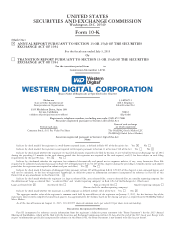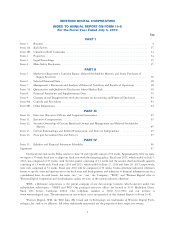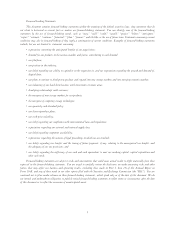Western Digital 2015 Annual Report Download - page 16
Download and view the complete annual report
Please find page 16 of the 2015 Western Digital annual report below. You can navigate through the pages in the report by either clicking on the pages listed below, or by using the keyword search tool below to find specific information within the annual report.but the higher input/output (“IO”) performance makes SSDs an attractive new tier of storage that fits between DRAM
memory and hard drives. SSDs are finding growing usage in enterprise storage systems and servers in applications that
demand the highest IO performance.
The non-volatile memory in use today for SSDs is NAND flash technology. While single-level cell flash provides
the highest endurance and performance, the optimal balance of price and performance is usually achieved through the
use of multi-level cell flash. Multiple NAND flash die are used on a single printed circuit board assembly (“PCBA”)
and connected in parallel through a controller to the host bus. Various performance classes of SSDs are created by
varying the number of parallel NAND channels and the speed of controller logic and firmware. The controller con-
tains hardware logic and firmware to buffer the data flow to and from the host, to the NAND flash, and to manage the
reliability and performance of the NAND flash media.
The typical host interfaces for SSDs include PCIe, SAS and SATA. PCIe products typically offer the highest per-
formance and come on edge cards that plug into the PCIe bus. PCIe defines the hardware and electrical interface but
the software protocols are still proprietary today. New standards such as NVMe and SCSI express are emerging to
bring more standardized software protocols for communicating with PCIe SSDs. SAS and SATA products utilize
standardized interfaces similar to hard drives and come in 2.5-inch form factors with differing package heights
depending on the application and usage. The typical power consumption for the SAS and SATA interfaces is similar to
hard drives, while the power consumption of PCIe form factor devices is typically higher.
Our products generally leverage a common platform for various products within product families, and in some
cases across product families, resulting in the commonality of components which reduces our exposure to changes in
demand, facilitates inventory management and allows us to achieve lower costs through purchasing economies. This
platform strategy also enables our customers to leverage their qualification efforts onto successive product models. For
a discussion of associated risks, see Part I, Item 1A of this Annual Report on Form 10-K.
Research and Development
We devote substantial resources to the development of new products and the improvement of existing products.
We focus our engineering efforts on coordinating our product design and manufacturing processes to bring our prod-
ucts to market in a cost-effective and timely manner. Research and development expenses totaled $1.6 billion, $1.7
billion and $1.6 billion in 2015, 2014 and 2013, respectively. For a discussion of associated risks, see Part I, Item 1A
of this Annual Report on Form 10-K.
Patents, Licenses and Proprietary Information
We have more than 7,000 active patents and have many patent applications in process. We believe that although
our active patents and patent applications have considerable value, the successful manufacturing and marketing of our
products depends primarily upon the technical and managerial competence of our staff. Accordingly, the patents held
and applied for do not ensure our future success.
In addition to patent protection of certain intellectual property rights, we consider elements of our product
designs and processes to be proprietary and confidential. We believe that our non-patented intellectual property, par-
ticularly some of our process technology, is an important factor in our success. We rely upon non-disclosure agree-
ments and contractual provisions and a system of internal safeguards to protect our proprietary information. Despite
these safeguards, there is a risk that competitors may obtain and use such information. The laws of foreign juris-
dictions in which we conduct business may provide less protection for confidential information than the United States
(“U.S”).
We rely on certain technology that we license from other parties to manufacture and sell our products. We
believe that we have adequate cross-licenses and other agreements in place in addition to our own intellectual property
portfolio to compete successfully in the storage industry. For a discussion of associated risks, see Part I, Item 1A of
this Annual Report on Form 10-K.
10
























